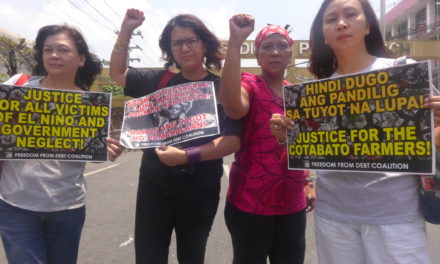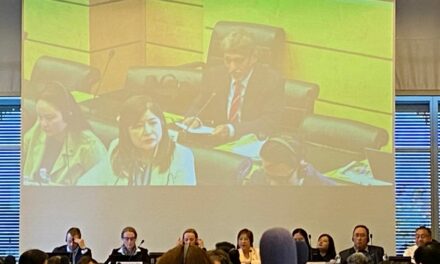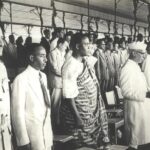by Aya Fabros
Kompleks Tun Abdul Razak (KOMTAR), in Penang, Malaysia, is a run down shopping complex revived and appropriated by migrants. Although frequented by foreigners, it is not your typical tourist spot, offering a glimpse to a grimier side of the global. Accommodating a neatly compartmentalized tapestry of different worlds, converging in a shared, borrowed space, Komtar— like Lucky Plaza in Singapore or Victoria Park in Hong Kong— reflects everyday negotiated practices carried out by migrant workers as they make room for themselves in their host locales, straddle transnational realities and navigate through global disparities.
Contrary to its reputation, on the inside, Komtar follows an implicit order — the containment policies toward migrant workers resonate with the placement of various sections carved out by different migrant groups. Hidden away in some awkward corner on the first level, a Nepali canteen provides Nepalese workers a place to meet, where they eat curry and momos, and enjoy drinks while listening to music from Kathmandu. Up in the main building, the second level houses the Burma section, followed by the Indonesian nook on the third floor and the Filipino area on the next level.
While groups largely keep to themselves, they do have a sense where the others are. There’s an acknowledged unspoken order, a systematized smorgasbord of various things Asian— where one can find batik, bagoong and Burmese publications offering the latest news on Aung San Suu Kyi. Although still not a widely recognized focal point, like Chinatown or Little India, once you walk around, you step into a space that is not only regional but also transnational, where interactions that traverse borders are carried out and sustained; where globalization’s rank and file retreats and congregates.
In Malaysia, it is estimated that 1 out of 4 workers is pekerja asing (foreign worker) employed in factories, plantations, the service sector or as domestic workers. Despite their number and Malaysia’s reliance on them, migrant workers remain undervalued, neglected, and invisible. Constructed as mere visiting, laboring bodies, they’re tied to employers and bound to their jobs through work permits that specify the name of their workplace, industry, and employer, who’s got practically absolute discretion to grant and cancel these documents. One worker observes, “They can dictate and change the terms of employment, pick and sack workers as they please, but we cannot choose employers or simply leave even when we are clearly disadvantaged.”
While workers concede that they came to Malaysia ‘to work,’ some also express that their situation is ‘parang walang laya’ (we don’t have freedom), working ‘as if we were slaves from old times’. Traveling far in search of employment, upon arrival many foreign workers contend with restricted movement and limited freedoms.They are confined to their workplaces and employer-managed living spaces, thrust into a position where they are practically isolated from others and heavily dependent on employers or agents, many of whom would not hesitate to take workers’ passports, threatening them with deportation to keep them passive and compliant. Disciplined to docility by a combination of intimidation, desperation and isolation, migrants consequently find themselves in a situation that also renders them vulnerable to abuse and exploitation within the workplace and beyond.
Contending with restrictions outside, within Komtar migrants appear to reclaim a sense of citizenship and agency. Here, they are not mere workers stripped of identities, plugged in as cogs on assembly lines or servants in shops and households. In this space, they are Filipinos or Burmese or Nepalese, and not simply victims of othering, imposed identities whereby Filipino means ‘maid’ and Burmese means ‘illegal.’ They are customers consuming choice products or sending home their hard earned pay; compatriots extending sympathy and support, exchanging opinions about their day-to-day travails or chronic ‘national issues’; members practicing presentations for church or community gatherings, planning activities or posting announcements and updates, all of which bear the imprint of an emerging sense of community.
While appropriating unwanted spaces and snubbed for being ‘dangerous and dirty,’ migrants are nonetheless constantly reminded of their ‘place’, even in this area, disrupted by routine raids, crackdowns and permanent police and omnipresent surveillance. Nonetheless, shop owners attach added meaning to the space, emphasizing the importance of remaining in business, because otherwise ‘where would they (migrant workers) go then?’
At a coffee place downstairs, two young men compare newly issued cards from the UNHCR (United Nations High Commission for Refugees), while waiting for another companion to take them to Alor Star, where relatives and friends are detained. Upstairs, a makeshift table is set for a game of tongits, while in the next room, a Filipina DH (Domestic Helper) belts out a lively rendition of “Top of the World” by the Carpenters.
In Komtar, people linger on for hours and come even without the intention of buying anything. “When you come to Malaysia, you are alone, you have no one, in Komtar somehow you do not feel that way,” a Filipina “domestic” points out. In this regard, Komtar functions as an agora for a polity in the diaspora, where dispersed individual workers, plucked from their homes and communities, are able to meet and mingle. There is no encompassing migrant collective consciousness per se nor an explicitly articulated notion of common projects, but within respective communities, a level of solidarity seems to be shared, nurtured and exercised in ways that at least fill the gaps left by their condition of non-citizenship. Here, migrants from Burma established “volunteer funeral services” and hospitalization support, formalizing their organization after countless cases of raising funds and arranging rites for workers who do not have access to these basic services. Other self-organized support groups provide relief and assistance to compatriots in distress, at the same time also mobilizing co-nationals around sociocultural events.
Komtar is constantly abuzz with a certain degree of dynamism and activity, teeming with possibility, even without yet posing any direct challenge to the deeply embedded injustices migrant workers face. While enjoying and carving out their own tenuous nooks and crannies, migrant worker expressions underscore that they do not intend to threaten their employment and stay. They are reclaiming a sense of agency and asserting a right to be here through some token symbolic presence and local imprint. These are nonetheless subtle articulations made on an uneven terrain where migrants tread carefully. For now, these everyday acts, seemingly mundane practices, almost collectivized by common experience and amplified by sheer number, glare against conditions that would isolate or make migrant workers invisible and inconsequential. As these communities take root, however, it will be exciting to observe how the spaces they engender will evolve and where their deepening solidarities may lead.









